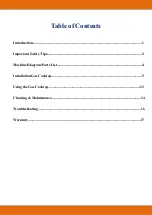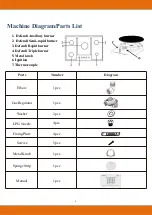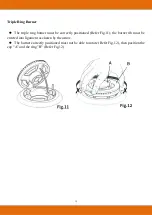
10
C) Leak Test
To prevent gas leaks, coat all external thread with compound or wrap teflon tape around
the pipe thread.
Install a manual globe valve in the gas line at an easily accessible location within safe
limits. Make sure all operators know where the gas supply is and how to turn off the
gas supply to the cooktop.
Install male 1/2” flare union adapter to the 1/2” NPT internal thread at inlet of
regulator. Use a backup wrench on the regulator fitting to avoid damage.
When installing the front, remove the 90° elbow for easier installation.
Install male 1/2” or 3/4” flare union adapter to the NPT internal thread of the manual
shut-off valve, taking care to back-up the shut-off valve to keep it from turning.
Connect the flexible metal connector to the adapter on the cooktop. Position the
cooktop to allow connection at the shut-off valve.
When all connections have been made, make sure all cooktop controls are in the off
position and turn on the main gas supply valve. Use a liquid leak detector at all joints
and connections to check for leaks in the system.
WARNING: Do not check for gas leaks by flame to prevent a fire hazard.
When testing a residential air supply system, disconnect the cooktop and separate
the globe valve from the gas supply line if the pressure is
>
1/2 psig.
When testing a residential air supply system, only close the separate globe valve to
isolate the cooktop from the gas supply line if the pressure is ≤ 1/2 psig.
Electrical Connection
The voltage is 120V/60Hz,
properly grounded dedicated circuit protected by a 15-amp,
20-amp circuit breaker or time-delay fuse.
Note
: Automatic, wireless, or wired external switches are not recommended for this
product to power down the device.
Extension Cord Precautions
We strongly recommend against using extension cords to reduce potential safety hazards.
If you still use extension cords, you must use a UL listed 3-wire grounding type with
current-carrying amperage ≥ branch circuit rating.






































